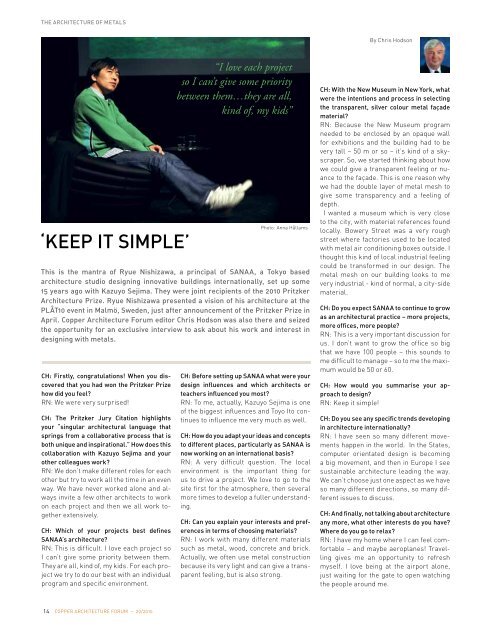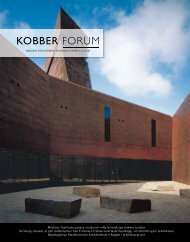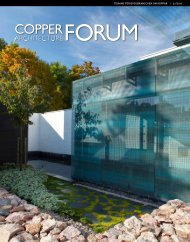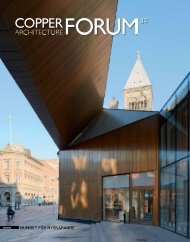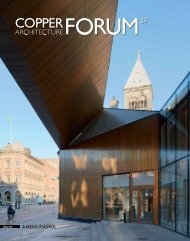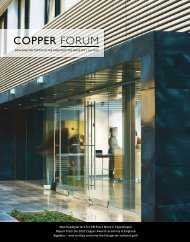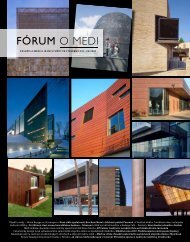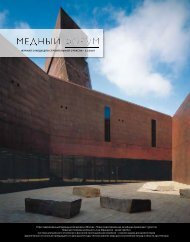renovation of the clock tower at Helsinki railway station - Copper ...
renovation of the clock tower at Helsinki railway station - Copper ...
renovation of the clock tower at Helsinki railway station - Copper ...
Create successful ePaper yourself
Turn your PDF publications into a flip-book with our unique Google optimized e-Paper software.
THE ARCHITECTURE OF METALS<br />
‘KEEP IT SIMPLE’<br />
This is <strong>the</strong> mantra <strong>of</strong> Ryue Nishizawa, a principal <strong>of</strong> SANAA, a Tokyo based<br />
architecture studio designing innov<strong>at</strong>ive buildings intern<strong>at</strong>ionally, set up some<br />
15 years ago with Kazuyo Sejima. They were joint recipients <strong>of</strong> <strong>the</strong> 2010 Pritzker<br />
Architecture Prize. Ryue Nishizawa presented a vision <strong>of</strong> his architecture <strong>at</strong> <strong>the</strong><br />
PLÅT10 event in Malmö, Sweden, just after announcement <strong>of</strong> <strong>the</strong> Pritzker Prize in<br />
April. <strong>Copper</strong> Architecture Forum editor Chris Hodson was also <strong>the</strong>re and seized<br />
<strong>the</strong> opportunity for an exclusive interview to ask about his work and interest in<br />
designing with metals.<br />
CH: Firstly, congr<strong>at</strong>ul<strong>at</strong>ions! When you discovered<br />
th<strong>at</strong> you had won <strong>the</strong> Pritzker Prize<br />
how did you feel?<br />
RN: We were very surprised!<br />
CH: The Pritzker Jury Cit<strong>at</strong>ion highlights<br />
your “singular architectural language th<strong>at</strong><br />
springs from a collabor<strong>at</strong>ive process th<strong>at</strong> is<br />
both unique and inspir<strong>at</strong>ional.” How does this<br />
collabor<strong>at</strong>ion with Kazuyo Sejima and your<br />
o<strong>the</strong>r colleagues work?<br />
RN: We don’t make different roles for each<br />
o<strong>the</strong>r but try to work all <strong>the</strong> time in an even<br />
way. We have never worked alone and always<br />
invite a few o<strong>the</strong>r architects to work<br />
on each project and <strong>the</strong>n we all work toge<strong>the</strong>r<br />
extensively.<br />
CH: Which <strong>of</strong> your projects best defines<br />
SANAA’s architecture?<br />
RN: This is difficult. I love each project so<br />
I can’t give some priority between <strong>the</strong>m.<br />
They are all, kind <strong>of</strong>, my kids. For each project<br />
we try to do our best with an individual<br />
program and specific environment.<br />
14<br />
COPPER ARCHITECTURE FORUM – 29/2010<br />
“I love each project<br />
so I can’t give some priority<br />
between <strong>the</strong>m…<strong>the</strong>y are all,<br />
kind <strong>of</strong>, my kids”<br />
Photo: Anna Hållams<br />
CH: Before setting up SANAA wh<strong>at</strong> were your<br />
design influences and which architects or<br />
teachers influenced you most?<br />
RN: To me, actually, Kazuyo Sejima is one<br />
<strong>of</strong> <strong>the</strong> biggest influences and Toyo Ito continues<br />
to influence me very much as well.<br />
CH: How do you adapt your ideas and concepts<br />
to different places, particularly as SANAA is<br />
now working on an intern<strong>at</strong>ional basis?<br />
RN: A very difficult question. The local<br />
environment is <strong>the</strong> important thing for<br />
us to drive a project. We love to go to <strong>the</strong><br />
site first for <strong>the</strong> <strong>at</strong>mosphere, <strong>the</strong>n several<br />
more times to develop a fuller understanding.<br />
CH: Can you explain your interests and preferences<br />
in terms <strong>of</strong> choosing m<strong>at</strong>erials?<br />
RN: I work with many different m<strong>at</strong>erials<br />
such as metal, wood, concrete and brick.<br />
Actually, we <strong>of</strong>ten use metal construction<br />
because its very light and can give a transparent<br />
feeling, but is also strong.<br />
By Chris Hodson<br />
CH: With <strong>the</strong> New Museum in New York, wh<strong>at</strong><br />
were <strong>the</strong> intentions and process in selecting<br />
<strong>the</strong> transparent, silver colour metal façade<br />
m<strong>at</strong>erial?<br />
RN: Because <strong>the</strong> New Museum program<br />
needed to be enclosed by an opaque wall<br />
for exhibitions and <strong>the</strong> building had to be<br />
very tall – 50 m or so – it’s kind <strong>of</strong> a skyscraper.<br />
So, we started thinking about how<br />
we could give a transparent feeling or nuance<br />
to <strong>the</strong> façade. This is one reason why<br />
we had <strong>the</strong> double layer <strong>of</strong> metal mesh to<br />
give some transparency and a feeling <strong>of</strong><br />
depth.<br />
I wanted a museum which is very close<br />
to <strong>the</strong> city, with m<strong>at</strong>erial references found<br />
locally. Bowery Street was a very rough<br />
street where factories used to be loc<strong>at</strong>ed<br />
with metal air conditioning boxes outside. I<br />
thought this kind <strong>of</strong> local industrial feeling<br />
could be transformed in our design. The<br />
metal mesh on our building looks to me<br />
very industrial - kind <strong>of</strong> normal, a city-side<br />
m<strong>at</strong>erial.<br />
CH: Do you expect SANAA to continue to grow<br />
as an architectural practice – more projects,<br />
more <strong>of</strong>fices, more people?<br />
RN: This is a very important discussion for<br />
us. I don’t want to grow <strong>the</strong> <strong>of</strong>fice so big<br />
th<strong>at</strong> we have 100 people – this sounds to<br />
me difficult to manage – so to me <strong>the</strong> maximum<br />
would be 50 or 60.<br />
CH: How would you summarise your approach<br />
to design?<br />
RN: Keep it simple!<br />
CH: Do you see any specific trends developing<br />
in architecture intern<strong>at</strong>ionally?<br />
RN: I have seen so many different movements<br />
happen in <strong>the</strong> world. In <strong>the</strong> St<strong>at</strong>es,<br />
computer orient<strong>at</strong>ed design is becoming<br />
a big movement, and <strong>the</strong>n in Europe I see<br />
sustainable architecture leading <strong>the</strong> way.<br />
We can’t choose just one aspect as we have<br />
so many different directions, so many different<br />
issues to discuss.<br />
CH: And finally, not talking about architecture<br />
any more, wh<strong>at</strong> o<strong>the</strong>r interests do you have?<br />
Where do you go to relax?<br />
RN: I have my home where I can feel comfortable<br />
– and maybe aeroplanes! Travelling<br />
gives me an opportunity to refresh<br />
myself. I love being <strong>at</strong> <strong>the</strong> airport alone,<br />
just waiting for <strong>the</strong> g<strong>at</strong>e to open w<strong>at</strong>ching<br />
<strong>the</strong> people around me.


